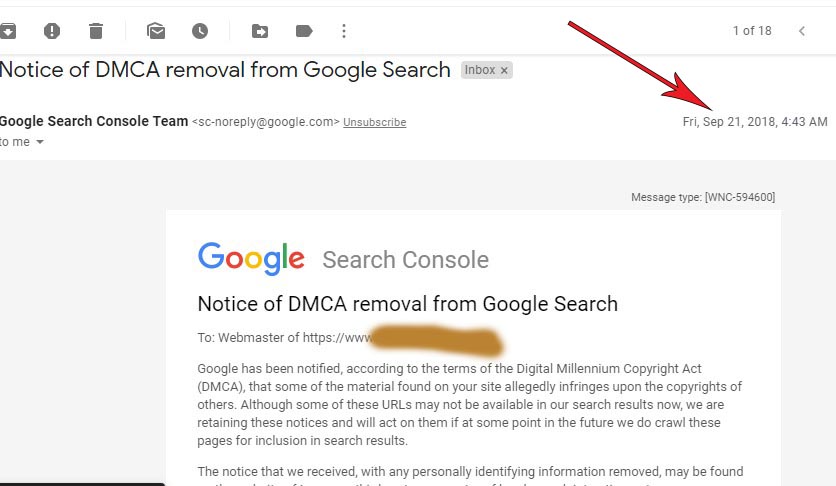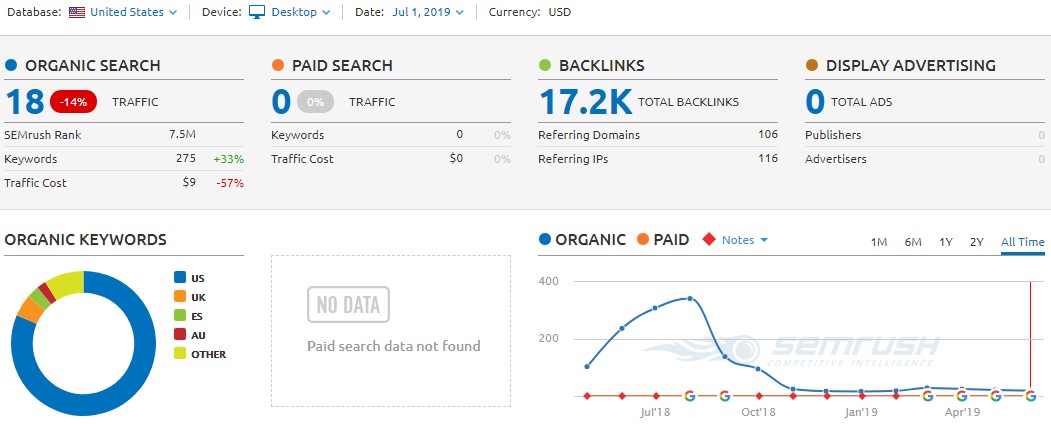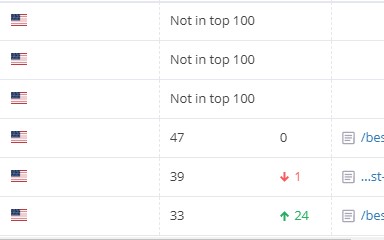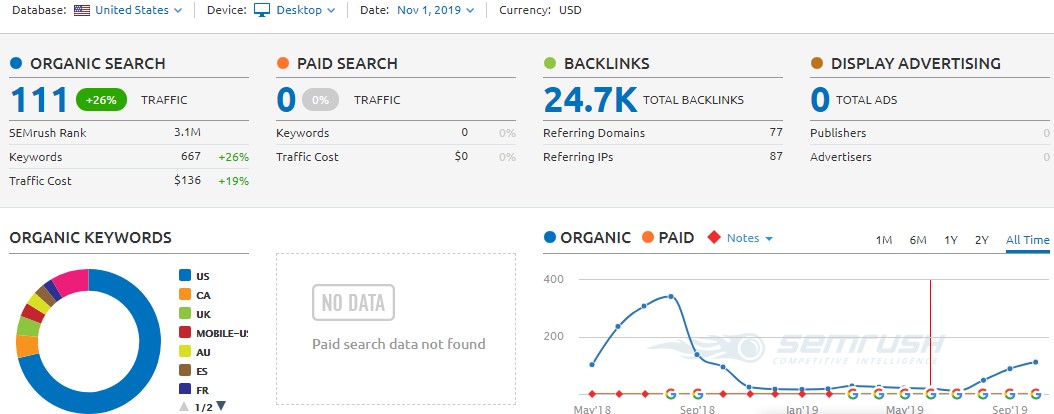Can you file and win a Google DMCA counter notice? Find out what happened when I filed one.
Running multiple niche sites at a go has its pros and cons.
When you have two or more sites, you are essentially NOT putting all your eggs in one basket. Should something happen to one site, you have the other as a backup. For example, when Google released the Medic Update last year, one of my main sites was hit pretty bad.
I felt the pinch. I lost income and traffic.
However, I still had a couple of sites that were not affected by the update. So, it’s not like I could not make ends meet. Still, that meant a drastic drop in income and I had to look for some side gigs. That’s when I started my content writing agency. You know, wherever you can get the money to fund your business, you have to get it.
The Case Against Multiple Niche Sites
Running multiple niche sites is a great way to cushion yourself against sudden Google updates, affiliate program changes, or any other number of things out of your control that can affect your income.
However, this also means that you are spreading yourself too thin. Instead of putting all your energy and effort on one site, you are spreading it around multiple sites. And this can slow down your growth.
When you are handling multiple niche sites, you never really get to know the problems of your audience in-depth. You don’t get to understand the lingo nor what the audience really cares about, apart from what your favorite keyword tool is telling you.
Apart from this, tracking work for multiple sites can be difficult if you are a one-man army (like myself). There’s content to be written, links to be built, outreach to be done, and so on.
At the beginning of the year, I decided to scale down my niche site projects. I decided to sell off some of the projects I’d started but wasn’t really focusing on. Apart from this, I just stopped tracking some of the sites. I would occasionally check my Amazon earnings to see how much income the sites were generating.
But I didn’t really do anything to grow or maintain the sites.
No content. No links. No nothing.
Anyway, a couple of days ago, I was looking to exchange links in one of the private Skype groups that I’m in. Someone wanted a link in the niche that I’m in. Great, easy way to score a link. As an after thought, I decided to check the metrics of my site.
To my horror, this is what I saw when checking the site on SEMrush:

Yes, that’s an estimate traffic of 2 visitors.
The site had lost about 90 percent of its traffic.
I checked the Statcounter traffic and this is what I saw:

From the traffic stats, you can see the site was at its peak towards the end of 2018, getting about 3,000 visitors per month.
The SEMrush stats really made me want to take a look at the site and see what’s going on.
Was this a penalty?
I decided to investigate.
I checked my content. Nothing suspicious.
Links. My usual PBNs and some random scrapers’ links.
And then, I saw this in my webmaster’s email:

Someone had filed a DMCA notice against my site way back last year.
The DMCA notice was sent on 21st, September 2018. Basically, the competitor claimed that my content was similar to his (i.e. I was using the same keywords in the title and images on the posts).
Now, to be honest, I am targeting the same keywords that he is targeting. However, this does not mean that he owns exclusive rights to the keywords. For example, how can someone claim that he is the owner of the keyword phrase “best diy home security system”?
Yes, I may have gotten inspiration from his (it’s what competition is all about), but I could also have easily found the keywords using manual research or different keyword research tools.
The other claim was that I was using his images. The truth is that all of us had posted images that the manufacturer had provided for the products. We’d not edited them in any way to make them “unique”. Perhaps the only issue I can see is that we’d not attributed the images to the product manufacturers. Either way, if any entity was to be pissed off in this case, it should have been the product manufacturer, whom we’ve are affiliates of.
So, from my point of view, this was a fake DMCA takedown.
With these two complaints, about 10 URLs of my highest traffic pages were removed from the SERPs due to the DMCA notice.
I just saw it today (7th June, 2019). That’s a whole 8 months later!
This explains why the site has been moving from 3000 visitors a month to just 2 visitors.
This experiment is meant to try to find out how long it takes for Google to bring back a site into the SERPs after a DMCA notice has been filed.
To be honest, I have no idea whether the experiment will work. Moreover, tracking the reinstatement with certainty can be difficult. So, it will be a matter of organized manual tracking.
Filing a Google DMCA Counter Notice
I’m not sure why people think countering a DMCA notice is difficult. All you have to do is go to this page and file a counterclaim. Basically, try to tell Google that the DMCA notice was written in bad faith and you have been nothing but good with your business.
In my case, the person who filed the claim is a competitor. Back in 2018, I was tracking his site and we had a healthy competition. Some of his keywords were No. 1 while mine was coming a close second, and vice versa. Whatever made him/her/them file a DMCA Notice against me is something I don’t know.
Anyway, I checked his site today and this is what SEMrush metrics look like:

Road to Recovery
So, this is my journal on my road to recovery. I want to see how long it will take for Google to reinstate the URLs.
Taking Stock
Before submitting a DMCA counter notice, I investigated the URLs that the competitor claimed I had copied content from him. The content is different, except that they were optimized for the same keywords as theirs. Nothing wrong with this.
Next, I checked the images on the URLs that were removed from the SERPs. The images were sourced from the manufacturer and, therefore, the complainant has no right to claim I stole them from him/her/them.
The next step is is filing the DMCA counter notice.
Update 1: 8th June. Submitted my DMCA counter notice
I submitted the DMCA counter notice. In the notice, I explained that the content that the person claims I copied is actually not his. I simply said I got the keywords from doing keyword research.
I also explained that the images I was using in my posts were sourced from the manufacturer’s site, and not the complainant’s site.
Here’s the message I received from Google.

Update 2: 12th June. Google Replied. Missing Information
So, it seems that I did not indicate my address when I filed the DMCA counter notice. I just got this email from Google.

And I just replied to the email with the information they needed:

And I got a reply back a few hours later…

Okay, so I’ll have to wait for 10 days for a decision.
No need to cross fingers…I’m confident like that.
Update 3: 27th June. URLs Reinstated
Just got the reinstatement notification from Google today.

Okay, so the process is over.
What about traffic? Here is what I have at this time from SEMRush.

So, it seems that traffic has started coming back. But I guess I still have a long way to go.
Update 4: July 1st.
I haven’t seen any significant increase in traffic since the reinstatement of my URLs. Here is what SEMrush shows for the traffic.
Perhaps it takes longer? I don’t know.
In the meantime, I’ve noticed the site has a lot of technical on-page errors. For example, I’ve seen dozens of 404 pages and content without CTAs. I’ll do a thorough audit with Screaming Frog and start fixing things. I hope this will help to jumpstart the traffic to those top pages.
Here’s is what Accuranker shows for the keywords I was targeting on the six money pages that had been removed from the Google’s index.

Update 5: August 1st.
I’ve not seen any significant improvements on the site in terms of rankings. The pages that were removed from search index have been reinstated but they have not gone back to ranking on page 1, as they were before.
For some perspective, here is what SEMrush shows:

Well, you can see that traffic has been declining. This may look like a bad sign. However, it is not. At least not entirely bad.
If you check the keywords and traffic cost, you’ll see that they’ve been increasing. This means that more keywords from the site’s pages are starting to get ranked on Google.
To be clear, I haven’t done any edits on the website as right now I’m concentrating on my 100K Project.
Here is what Accuranker shows for the keywords that I’m tracking. These are the keywords that fell after the pages were removed from search index:

Well, one of the articles is on page one, while the rest are on pages 2, 3, and 4. There are also 5 that are not in the top 100.
Update 6: September 1st.
There wasn’t much activity in terms of traffic on the site in September. For the first time, we’re seeing an increase in traffic. Here is what SEMrush show.

However, the traffic is not as much as it was when the site was ranking on the first page of Google for various keywords.
The first keyword has now started ranking on page one. However, it is at the lowest end (fluctuating between position 9 and 10).
So, there we go, a whole 2 months to get the first keyword to rank on page 1.
At this point, I must recognize that some Google updates have happened since the URLs were last removed from the SERPs. Therefore, I cannot guarantee that they will move to the first pages as they were before. However, I will continue monitoring them this month before I start making some changes such as on-page optimization.
Update 7: October 1st.
October is here and the site’s traffic has been steadily improving, but at a slower rate than I anticipated. More keywords are getting picked up by Google as SEMRush shows below.

From checking Accuranker, I see that all the keywords that were ranking on the pages that had been deindexed have risen to page two and one of Google SERPs. This explains why the traffic is not yet at the level where it was before.
Moreover, there were a couple of Google updates in September. Perhaps this is why the keywords have not gone to page one? I have no idea whether my site was impacted since the traffic has already gone down.
With the Google updates having been rolled out, I won’t be able to get true data to show how long it takes for a site to recover from a DMCA penalty. So, it makes no sense to continue with the case study.
With that said, as I’d indicated in last month’s post, I will now start doing some on-page optimization on the site.
I will keep updating the case study with SEMRush stats for the next 2 months before officially ending it.
Update 8: November 1st.
I did nothing on the site in October. I’d planned to do some on-page optimization but got too busy with other projects.
Regardless, the website’s traffic has continued to increase. Currently, it’s getting about 50 visitors a day, which should be about 1500 a month.
It’s now just four months since the site was reinstated back on Google’s index. Here is what SEMRush shows on 1st Nov.

I think if I’d done some onpage optimization, the site would have done much better.
Here is how the keywords are performing based on Accuranker:
![]()
Just this month again, Google released another update known as the BERT update. I’m not sure how this is going to affect my site.
However, I’ve come to the conclusion that no matter how the site ends up performing, it is not going to be easy to determine how long it takes for a page to recover after being deindexed due to a DCMA takedown request. This is because Google has been rolling out various updates since pages of the site were reinstated back into the SERPs. Thus, it’s not easy to determine whether the site’s performance has been influenced by the updates.
With that said, I intend to continue tracking the site until December. After then, I’ll end the case study.
Update 9: December 1st.
So, here’s the last update for this case study. Traffic to the site has been steadily increasing. In fact, I’m now constantly seeing 70 to 100 visits a day. Perhaps it’s the holiday rush or the site has gotten back into Google’s grace.
Here is how the SEMrush stats looked like on 1st December, 100% increase in traffic.

I’ve also noticed my Amazon earnings from the site have been steadily climbing. I’m happy with this.
For the keywords that were affected by the deindexation, here’s how they’re looking at the moment:

The keywords look like they are in the same position as they were last month. However, I’ve seen a significant increase in traffic ever since the deindexed URLs got reinstated in the search index. Here’s how the traffic graph looks like from Statcounter.

Going with the current stats, I should be able to get over 3000 visitors to the site organically in December.
Lessons Learned + Next Moves
Well, this case study didn’t really go well as I had hoped. I can’t say that I now know for certain how long it takes for a page that has been deindexed to regain its position in the SERPs after reinstatement. This is because the various updates that Google has been pushing during the course of this case study may have affected the outcome.
However, I can say it should take about 4 to 6 months for the pages to get back to where they previously were.
For this case study, one thing that I’ve learned is to always keep a close eye on my sites. Whenever I see a significant drop in traffic, I’ll be hopping in to investigate to see whether the drop results from a manual penalty or some other factor.
Apart from this, I’ve been happy that I was able to document this case study for 6 months. Documenting the case study really gives a clear overview of the progress being made.
This marks the end of this case study. However, it also marks the beginning of my effort of scaling the site. I have a couple of ideas I have on the pipeline that can easily take the site to a $1000 niche site over the next year. I will be implementing the ideas, and may perhaps even write a follow-along case study on the blog.
Thanks for taking time to read this update. Until next time, cheers!
UPDATE: I’m Building the Site to Flip it for 100K!
I’m writing a case study on how I’m building the above website with an aim of flipping it for $100K. Follow the case study here.




![Case Study: Do Web 2.0 Links Work for Niche Sites? [Episode 1] Case Study: Do Web 2.0 Links Work for Niche Sites? [Episode 1]](https://www.nichesitevault.com/wp-content/uploads/2017/03/web-2.0-experiment-81x58.jpg)
